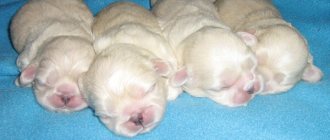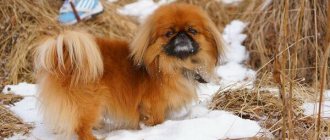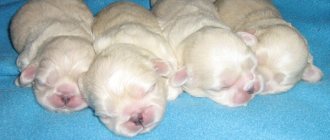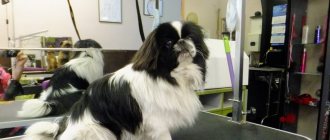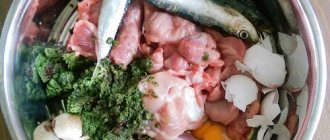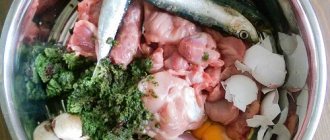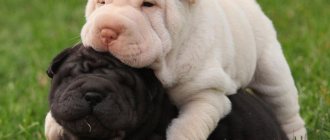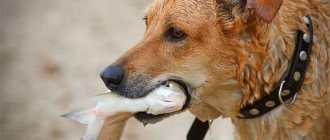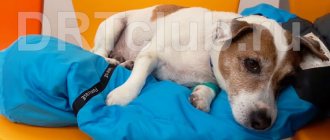A balanced diet is the basis for the proper development of any dog. It is important for owners to know what will be preferable: industrial dry food or natural food prepared from fresh ingredients. Let's consider what to feed the Pekingese. After all, this breed has its own developmental and physique characteristics that must be taken into account.
Features and rules of feeding Pekingese
The following tips will help you properly organize the nutrition of puppies and adult Pekingese:
- Food should be at room temperature to avoid negative effects on the digestive system.
- Feeding the Pekingese is carried out by the hour at regular intervals. Then the gastrointestinal tract will work smoothly.
- The dog is given a separate place for feeding. It is chosen once and does not change throughout life.
- Both puppies and adult Pekingese have no sense of proportion. Despite the fact that they have a small stomach, they are able to eat much more than normal. Therefore, the owner should control the amount of food consumed and avoid overfeeding.
- Due to the structure of the muzzle, it is inconvenient for animals to eat liquid food. They also have poorly developed fangs, which makes it difficult to chew dry food pellets and hard foods. It is recommended to soak the former in water, and cut the latter into small pieces.
- Clean water should always be within reach. It is updated 3-4 times a day.
- If the Pekingese is capricious and does not want to eat any product, the bowl is removed. After 20-30 minutes they take her out again. A hungry dog is unlikely to refuse food.
Varieties
A lot of time has passed since the appearance of the breed, which may be why this species has undergone some changes. It is now generally accepted that Pekingese are divided into species. But this is far from true. In order to understand what we are talking about, you need to know a number of nuances.
Mini Pekingese
This is not a separate species, but only a simple variety. The fact is that dwarf dogs can appear in the litter of quite large individuals. It is believed that this is a culling. Such representatives are not allowed to attend exhibitions.
Some say that short stature can be determined only when the puppy is 8 months old. Other breeders claim that babies are born very small and in the process of growth significantly lag behind their brothers, although they have an excellent appetite and are very active.
By and large, this deviation is not something out of the ordinary. Having bought such a pet, you will appreciate its qualities:
- the little ones are very smart - they perfectly understand human gestures and are very friendly;
- The small stature of a domestic dog is more of a plus than a minus.
Purebred Pekingese
Some breeders proudly call their pets “royal” or “imperial”. They do this in order to sell puppies at a higher price. Real Pekingese were bred to communicate with emperors anyway. Therefore, purebred representatives look graceful.
And if we already touch on standards, then it should be noted that there are no varieties among Pekingese. It's just such a breed.
Japanese Chin
Some people confuse Pekingese and Japanese Chins. These breeds are very similar. They are similar in appearance to a lion. Previously they belonged to emperors, but not Chinese, but Japanese. Ordinary people were not even allowed to look towards the Chins. They were also revered and associated with religious customs.
The profile of this dog is snub-nosed, and the colors come in a variety of colors, but most often they are red, fawn, and shades close to these colors. This dog’s nose is black and is at the same level with the eyes, and the eyes seem to be outlined with a black pencil. The coat is long and silky. Weight is small - about 3 kg. The large head corresponds to the size of the body. The tail is thrown gracefully over the back. The fur falls beautifully down the back to the floor.
Crossbreeds
Now we need to talk about half-breeds. They appeared as a result of mating of different types of dogs with similar appearance. These representatives come in different colors. From red to black and white. And there are even short-haired and smooth-haired half-breeds. But we must remember that there can be no talk of any standards here. You need to forget about various exhibitions where the most purebred representatives are present, just like about pedigree breeding if you decide to get a hybrid dog.
The most popular crossbreed is the Pickapom (Pekingese-Spitz hybrid). Dogs are intelligent and playful. But they cannot stand loneliness. There is a cross between a Pekingese and a pug. A cute dog who has absorbed all the best from both breeds. When dog breeders tried to combine the Shih Tzu and Pekingese breeds, they hoped to influence the lengthening of the coat. The puppies have absorbed the best qualities. They practically do not shed and have an easy-going nature.
What type of food should I choose?
Veterinarians and dog handlers have still not come to a consensus on what is better to feed the Pekingese: ready-made food or natural food.
Each approach has both advantages and disadvantages. But if you take a responsible approach to preparing the diet, your pet’s health will not suffer in both cases.
Important. Mixing two types of food is prohibited. A sudden change in menu causes indigestion, which is dangerous to health.
Ready-made dog food
Dry food for Pekingese must contain:
- natural meat, not offal;
- cereals and vegetables;
- vitamin and mineral supplements.
This composition will fully satisfy the body's nutritional needs.
Pekingese can be fed super premium or holistic products for small long-haired breeds. When choosing, take into account the individual characteristics of the pet:
- weight;
- age;
- presence of illness or pregnancy.
There are hypoallergenic and medicinal lines designed for dogs with various diseases. They help normalize the functioning of internal organs, strengthen the immune system and correct weight.
Most owners feed adult animals with the following brands:
- Orijen;
- ProPlan;
- GoldenEagle;
- Bosch;
- Acana;
- Piccolo;
- GO! NATURAL Holistic;
- Grandorf.
It is allowed to alternate wet canned food and dry food. The former add variety to the daily menu and do not cause thirst, while the latter gently cleanse teeth of plaque.
Important. Pekingese are not suitable for food labeled “Active” and “Sport”. Because of them, sedentary dogs gain excess weight.
Natural products
The owner needs to make the natural diet varied. Otherwise, your pet will quickly get bored with the same food and begin to refuse food.
In addition, this way the dog will receive a maximum of useful substances, which will have a positive effect on its health and appearance.
What you are allowed to feed adult Pekingese at home:
- lean meat - beef, rabbit, chicken, turkey;
- offal - heart, tripe, chicken offal, kidneys, liver;
- sea fish - horse mackerel, mackerel, halibut, etc., except pollock;
- porridges – rice, buckwheat, millet, oatmeal;
- fermented milk products - kefir, cottage cheese, bifidok, yogurt without dyes and fillers;
- vegetables - fresh carrots and tomatoes, boiled zucchini, beets, cauliflower;
- greens - parsley, sprouted oats, lettuce;
- fruits - bananas, pears, nectarines, apples.
It should be noted that when switching to another type of nutrition, it is important to act gradually. For about 2 weeks, first replace ¼ portion, after 3-4 days 2/4, etc.
What should you not feed your Pekingese?
Both a puppy and an adult Pekingese should not be fed the following foods:
- salted, fried, spicy, pickled dishes;
- freshwater fish;
- tubular bones;
- sweets and baked goods;
- semi-finished products;
- raisins, grapes, kiwi and citrus fruits;
- foods containing cocoa and caffeine;
- fatty meats, smoked meats and sausages;
- corn, legumes, potatoes, soybeans, white cabbage, semolina.
It is prohibited to encourage begging from the host's table. If you want to treat your Pekingese, you can give him a piece of dry food, meat or fruit.
Prohibited Products
When compiling a Pekingese diet, you need to know which foods can be given to the Pekingese and which are absolutely not allowed. These include:
- salt and any types of seasonings, onions. Adding large amounts of salt and spices to food leads to the development of cardiovascular diseases;
- pollock - this type of fish contains harmful substances;
- white cabbage, legumes, potatoes - can lead to bloating and diarrhea in your pet;
- flour products – lead to the opposite effect, slowing down the intestines;
- chocolate is strictly prohibited. In quantities of more than 7 grams can lead to the death of a four-legged friend;
- Milk – There is heated debate over its use in dogs’ diets. If the owner notices that the pet's stool is upset after drinking whole milk, then it should be prohibited.
How many times a day should I feed?
The number of meals depends on the age of the animal. As the puppy grows, they are fed less and less, gradually moving towards two meals a day.
Up to 1.5 months, food is given 6 times a day, even at night, because puppies can only eat a small portion at a time. Subsequently, the frequency is reduced:
- from 1.5 to 3 months – 5 times;
- from 3 to 6 months – 4 times;
- from 6 to 12 months – 3 times.
A one-year-old Pekingese is considered an adult. It is enough to feed him only in the morning and evening. If you don't walk or play with your dog much, it is acceptable to limit yourself to one meal.
The daily amount of food is calculated using the formula: 70 g of feed per 1 kg of weight.
For example, an adult Pekingese weighing 4 kg should be given 280 g of food per day.
However, each dog is individual, so the owner must monitor its condition. You should not allow yourself to gain excess weight, because this is fraught with problems with digestion, heart and blood vessels.
brief information
| Breed name | Pekingese |
| Country of origin | China |
| Time of appearance of the breed | More than 3000 years ago |
| Breed type | Decorative dog, companion |
| Adult dog weight | Up to 5 kg |
| Height (height at withers) | Up to 25 cm |
| How long do they live? | 15 years |
| Popular nicknames | Maya, Tessie, Charlie, Cody, Mars |
What to feed a Pekingese puppy?
Its proper development and health depend on what a dog eats in the first year of life.
An unbalanced diet for a puppy threatens growth retardation and the appearance of chronic pathologies.
Diet in the first month
For the first 4 weeks after birth, puppies are breastfed. Together with milk, they receive all the nutrients necessary for growth and antibodies that form immunity.
When there is not enough milk, puppies are fed special formulas. They are purchased from veterinary pharmacies and bred according to instructions.
For up to 12 days, bottles with a nipple are used for feeding, then the food is poured into a shallow saucer.
Important. Baby or kitten formulas are not suitable for puppies - they do not meet the needs of a dog's body.
Diet up to six months
Complementary foods are introduced at one month of age. Many breeders believe that it is better to feed babies with natural products. If necessary, the transition to dry food can be made when the pet becomes an adult.
A one-month-old puppy can eat:
- preferably goat's milk, but low-fat cow's milk is also suitable;
- chopped meat;
- meat broth.
If the baby is developmentally delayed, in consultation with the veterinarian, special supplements are purchased for malnourished puppies.
At 2 months, the pet is usually handed over to new owners.
To avoid health problems, you need to feed your Pekingese puppy in the usual way.
Gradually the diet is enriched:
- porridge;
- vegetable purees;
- fermented milk products.
At 2 months, a puppy eats about 180 g of food per day. It is divided into small parts so as not to stretch the stomach.
At 3 months, soft-boiled eggs are added. The portion is increased by 20-30 g.
From 4 months, the puppy is allowed to feed offal. The amount of kefir and cottage cheese is increased because teeth change begins, and the dog needs increased doses of calcium. Calcined supplements are administered on the veterinarian's recommendation.
By 6 months, the puppy is fed the same foods as an adult dog. However, he gets food more often because he continues to grow.
Diet from six months to a year
The puppy continues to be fed intensively to ensure proper development. It is advisable to exclude milk by this time, because adult Pekingese cease to absorb it. Instead, puppies are given fermented milk products.
The food remains high in calcium and protein for up to a year, because the skeleton and muscles are not yet formed.
When the puppy turns one year old, he begins to be fed in accordance with the norm for adult dogs.
Diet for adult dogs (one year and older)
The basis of an adult dog’s diet (about 50%) is meat products. Organ meats are less nutritious than whole meats. Therefore, their number should be increased by about a third.
Meat can be given raw if the owner is confident in its quality. Otherwise you need:
- scald it with boiling water;
- boil;
- freeze for 2-3 days to kill parasites.
An adult Pekingese is fed porridge with boiled fish fillet, which replaces meat, 2 times a week. River fish is not suitable because it contains many small bones. They can get stuck in the esophagus and injure the animal’s delicate gastrointestinal tract.
Adult Pekingese are not picky when it comes to cereals. However, they should not be fed instant cereals. It is important not to overcook the dish - the dog will most likely refuse food that resembles jelly in consistency.
Once a week, boiled yolk is added to the food of puppies and adult Pekingese. The egg can be anything:
- chicken;
- goose;
- quail;
- turkey.
It is better to avoid raw eggs - there is a high risk of infecting your pet with salmonellosis.
Adult Pekingese are given vegetables both boiled and raw. The optimal amount is 20% of the daily food volume.
Both puppies and adult Pekingese willingly eat a variety of fruits. They can be fed to your pets throughout the day or used as a reward for training.
For your information. If an adult Pekingese is fed normally, the spine and ribs can be clearly felt under the muscular corset. With a balanced diet, the coat is thick and shiny.
The table shows an indicative menu for an adult Pekingese for a week.
| Day | Feeding time | Products |
| 1 | Morning | Beef with vegetables |
| Evening | Boiled chicken, cottage cheese with fruit | |
| 2 | Morning | Fish porridge |
| Evening | Boiled liver with vegetables | |
| 3 | Morning | Meat porridge with egg yolk |
| Evening | Chicken with herbs and cottage cheese | |
| 4 | Morning | Boiled heart, porridge, kefir |
| Evening | Rice, beef pieces, vegetables | |
| 5 | Morning | Meat porridge with cottage cheese |
| Evening | Porridge with vegetables, cottage cheese with fruits | |
| 6 | Morning | Fish porridge |
| Evening | Meat porridge with vegetables | |
| 7 | Morning | Rice with turkey |
| Evening | Porridge with vegetables, cottage cheese |
Care
So, what do you need to know about the care and maintenance of the Pekingese? Let's figure it out. Let's start with the ears.
Behind the ears
The dog's ears have long hair. You should constantly inspect your pet's ears while brushing. Sulfur removal is done with a cotton swab, which must first be moistened in a disinfectant solution (can be purchased at a pet store). If the ears are constantly itching and the dog is constantly shaking his head, then this is a signal to visit the veterinarian.
Behind the wool
Pekingese have long hair with a thick undercoat. This is one of the main decorations of this breed. Therefore, caring for a Pekingese, first of all, involves taking care of the coat, i.e. grooming. At home, the dog needs to be brushed not just often, but daily. The ears, chest, sides, and area under the tail require especially careful combing.
To brush your Pekingese, you will need a long-handled metal comb and a wire brush. When it's hot, your dog could use a haircut. Specialists will groom your Pekingese “like a lion,” and he will be simply magnificent. You can bathe your dog no more than twice a month, but you shouldn’t wash your pet’s face - just wipe it with a damp cloth every day.
Related article: How to give a fashionable haircut to a Yorkshire Terrier at home
Behind the teeth
If you feed your dog a balanced professional food, then most likely your pet’s teeth will be healthy. While chewing the granules, the natural plaque is removed. You can often notice yellow discoloration and stains on the teeth. Contact your veterinarian for professional dental calculus removal. To prevent tartar from forming, try brushing your pet’s teeth with a toothbrush, but not all Pekingese agree to put up with this procedure.
Behind the claws
Representatives of this breed are not fans of running, which is why Pekingese claws require special care. Nail trimming should be introduced when Pekingese dogs are still puppies. This should not be done often, only when necessary. When trimming claws, only the very tip is cut off; the hair between the toes also needs to be trimmed. If the claws are not given proper attention, this can lead to damage to the claw. Of course, the procedure for trimming nails does not require haste. Purchasing a nail clipper from a specialized store will greatly ease the situation.
Feeding
Feeding is one of the most pressing issues for Pekingese owners. Dogs tend to be picky about food. A feature of the breed is the underdevelopment of fangs, so the meat should be finely chopped or twisted in a meat grinder. Meat and offal are lightly boiled. Cheese is rarely given, except as a reward.
Feeding with vegetables is carried out once a week. Use only those that do not cause bloating. Fermented milk products are given separately or with fruit. Pickles, smoked meats, pasta, potatoes, anything fried, chicken and fish bones are strictly prohibited. To prevent the formation of tartar, you can give beef bones. Proper nutrition will help the owner avoid such an unpleasant problem as diarrhea in the Pekingese.
Clothing and walking
When the weather is cool outside, despite its long coat, the Pekingese will need clothing. In your winter clothes wardrobe it would be nice to have a warm jumpsuit with padding polyester. Choose a soft fabric, and the overalls themselves should not hinder movement. The dog should feel comfortable in it. In wet weather, clothing for the Pekingese is a jumpsuit with a hood. It is needed to hide long ears. In the summer, a mesh jumpsuit would be a good idea. Of course, the dog is not cold, but protecting its beautiful coat from dust and mites will be very useful.
It’s good if your pet doesn’t have fleas, but as a useful accessory to a summer outfit, a flea collar will be useful. Fashion designers for dogs offer a very useful thing - soft boots. They will protect your paws from dirt and salt on the roads. You can attach a bow to your pet's leash as a decoration. Pekingese are not couch dogs; you need to take them for walks regularly.
What to feed an older dog (old dogs)
Pekingese live on average 12-15 years. From the age of 8 the pet begins to age. At this age, adjustments should be made to his diet.
An aging dog is fed mostly soft food because its teeth become less strong. If the Pekingese is accustomed to dry food, buy products from lines for older animals.
Since the dog moves even less than usual, the caloric intake of the diet is reduced. The amount of cereals is kept to a minimum, replacing them with vegetables and meat. To maintain healthy bones and joints, include glucosamine and chondroitin supplements.
Important. For better absorption of food, the daily intake is divided into 4-5 small portions.
A veterinarian will give individual recommendations for feeding an aging Pekingese, taking into account the animal’s health condition.
If you have illnesses, a specialist will prescribe auxiliary supplements and help you choose a diet.
What to feed your pet during pregnancy and after birth?
The diet of an adult Pekingese is changed from about 30 days, because until this moment the puppies do not develop as intensively.
From week 5, the daily rate is increased by approximately 15% every 7 days. The Pekingese is fed 3 times at first, and by the end of pregnancy - 4-5 times a day. Portions are made small so as not to overload the stomach, which is squeezed by puppies.
Pekingese are given more meat, vegetables and fruits. Together with the veterinarian, feed additives are selected.
For your information. If the Pekingese is fed dry food, then it is switched to products for pregnant dogs.
Nursing Pekingese also need more food, so they continue to be fed the same way as in the second half of pregnancy.
Immediately after birth, food is given about 7 times a day. It is crushed to a mushy consistency. Fresh vegetables are pre-boiled.
By the end of the first week, the frequency of feedings is reduced to 5 times a day, but the total volume of food is still approximately 1.5 times the norm.
When all the puppies are taken apart, the amount of food is adjusted to the usual amount.
Origin
Pekingese (English: Pekingese) is a dog belonging to small and dwarf breeds.
There is also another name for the Pekingese - the lion dog, which refers us to the legends about its origin (according to them, one of the ancestors of this dog was none other than a lion). The Pekingese comes from China and the first historical mentions of dogs similar in description to the Pekingese date back to the 6th–7th centuries BC, that is, according to the most conservative estimates, the Pekingese is already more than 2500 years old! In China, which developed for a long time separately from European civilization, dogs of this breed belonged to the elite. Thus, Pekingese lived with the imperial family and were revered as protectors from evil spirits. The nobility carried dwarf dogs with them at the ceremony, according to some sources, in the sleeves of their kimono. Commoners could not be the owners of Pekingese, and stealing them for the purpose of selling or owning them was punishable by death.
Until the mid-19th century, Pekingese practically did not leave the Celestial Empire, but after the capture of the residence of the Chinese emperors by British troops in 1860, Pekingese were taken to Europe, where they also became the favorite dogs of kings and lords. Even now, looking at photos of these small dogs, you can easily imagine Ancient China, and understand why the Pekingese was considered a royal dog!
Be that as it may, over 150 years of free breeding, the Pekingese has spread widely throughout the world, and at the moment, purchasing a “lion dog” puppy is not difficult. It is recommended to choose puppies from trusted breeders and be sure to get to know the animal before taking it home. Be sure to ask the breeder about the care of the animal, its pedigree, and look at the mother of your future Pekingese.
Vitamins and mineral supplements for Pekingese
If Pekingese are fed natural products, they must be given vitamin and mineral complexes. Then both the adult dog and the puppy will receive all the elements necessary for health.
Supplements recommended for Pekingese:
- Unitabs ImmunoComplex – contains coenzyme Q10, normalizes metabolism, increases resistance to infections;
- WOLMARWinsomeProBioBoosterCaMini – multivitamin complex with calcium restores intestinal microflora and prevents disruptions in mineral metabolism;
- 8 in 1 ExcelMultiVitaminSmallBreed – indicated in the off-season for the prevention of vitamin deficiency in puppies and adult dogs, prevents problems associated with an inadequate diet.
Vitamin supplements are not used when feeding dry food, because all the necessary elements are already included in it.
Recommendations from experts
The following advice from veterinarians and dog handlers will help you properly feed puppies and adult Pekingese:
- During the first molt, when baby hair changes to adult hair, the menu is enriched with algae, mussels, oysters and other seafood. However, you need to remember that you cannot feed your Pekingese these foods at an earlier age.
- In summer, an adult Pekingese should eat more fiber, and in winter, protein foods.
- It is not recommended to rely heavily on buckwheat, because it can cause urolithiasis.
- The bowl is removed 20 minutes after the start of feeding. If there is food left in it, the portion size is reduced, and if the dog continues to lick the empty dishes, it is increased.
- You should not offer your pet treats often, because then he will refuse to eat regular food.
- Sedentary adult Pekingese dogs should consume about 300 calories per day. With moderate activity, the energy value increases to 400 calories, and with high loads - up to 600 calories.
If you feed your Pekingese correctly from childhood, he will have good health, which means he will live a long life. Therefore, the owner needs to take the most responsible approach to preparing a diet for a puppy and an adult dog.
